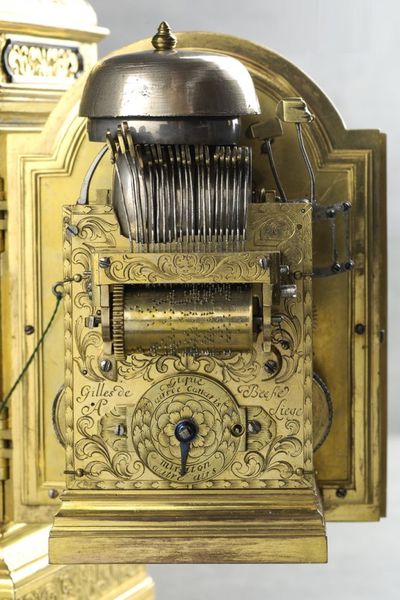Datei:Gilles de Beefe à Liège, circa 1750 (08).jpg

Originaldatei (567 × 850 Pixel, Dateigröße: 170 KB, MIME-Typ: image/jpeg)
Gilles de Beefe à Liège, Höhe 240 mm circa 1750

|
Alle Bildrechte liegen bei dem Auktionshaus Auktionen Dr. H. Crott. Diese Abbildung ist urheberrechtlich geschützt und steht nicht unter einer freien Lizenz. Für anderweitige Nutzungen außerhalb von Watch-Wiki ist die schriftliche Zustimmung des Urheberrechtsinhabers nötig. |
Museale, belgische Barock Tischuhr mit Halbstundenrepetition und Halbstunden-/Stundenselbstschlag und zwei Melodien spielendem, halbstündlich auslösenden Carillon Geh.: Messing feuervergoldet, vierseitig verglast. Ziffbl.: Messing, feuervergoldet, signiert, aufgelegter Champlevé Silberziffernring, Silberbeschläge, Ausschnitt für Scheinpendel. Werk: rechteckiges Messing-Vollplatinenwerk in drei Ebenen, signiert, floral graviert, 3 x Kette/Schnecke, 2 Hämmer/2 Glocken, Spindelhemmung, Stahlringunruh. Musikspielwerk: Vor der halben Stunde und vor dem Stundenschlag halbstündlich auslösend, Stiftenwalze, 21 Hämmer / 6 Glocken.
Das hochrechteckige Gehäuse auf vier gedrückten Kugelfüßen mit profiliertem Sockel und Gesims ist auf auf allen Seiten aufwändig punziert und dekoriert mit Voluten und Akanthusranken. Der Sockel ist auf der Vorderseite mit einer Schublade versehen. Die verglasten Türen auf der Vorder- und Rückseite haben einen bogenförmigen, profilierten Giebel. Der profilierte Glockenaufsatz ist mehrfach geschwungen und seitlich durchbrochen gearbeitet, bekrönt von einem mit Akanthus verzierten Tragegriff. Das feuervergoldete Messingzifferblatt hat einen aufgelegten silbernen Champlevé Zifferring mit römischen Stunden und arabischen Minuten. Das vergoldete Zentrum ist aufwändig mit Vogeldekor graviert und hat eine halbkreisförmige Öffnung für das Scheinpendel, oberhalb befindet sich einer Regulierskal. Die Zwickel und der bogenförmige Ausschnitt mit silberner Ziffernring sind verziert mit aufgelegtem silbernen Rankendekor. Das rechteckige Vollplatinenwerk ist vollflächig mit Rankwerk aufwändig und sehr fein graviert. Das Carillon hat 6 Glocken und 21 Hämmer und wird von der Vorderplatine über eine springende Auslösung zur vollen Stunde in Tätigkeit gesetzt. Es betätigt auf der Rückplatine eine justierbare Nockenscheibe, die über eine Kadratur nach beendetem Musikstück den Stundenschlag auslöst. Mit Hilfe der unten angebrachten gravierten Scheibe und eines kleinen Zeigers wird eine von zwei Melodien ausgewählt.
An important Baroque half hour repating table clock with half hour/hour strike and carillon with two different tunes activating on the half hour Case: brass, firegilt, glazed on four sides. Dial: brass, firegilt, signed, applied silver champlevé chapter ring, silver frets, aperture for mock pendulum. Movm.: rectangular brass full plate movement on three levels, signed, florally engraved, 3 x chain/fusse, 2 hammers/2 bells, verge escapement, steel ring balance. Muscial movement: Released automatically on the half hour or on the hour by the clock followed by the half hour or hour strike, pin barrel, 21 hammers / 6 bells.
The high rectangular case sits on a moulded base with four bun feet and has a pediment. It is elaborately decorated with chasing and volute and acanthus scrolls. The base has a front drawer. The glass doors on front and back are arched with moulded ornamentation at the top. The moulded bell structure on top of the case is curved and pierced on the sides; the carrying handle is decorated with acanthus ornaments. The firegilt brass dial features an applied silver Champlevé chapter ring with Roman hours and Arabic minutes. The gilt centre is lavishly decorated with bird motifs and shows the mock pendulum in a semicircular aperture; above it sits an adjustment scale. The spandrels and the arched opening with the silver chapter ring are decorated with applied silver scrolls. The rectangular full plate movement is allover intricately engraved with fine scrollwork. The carillon has six bells and 21 hammers and is released at the hour via the front plate; after the tune the carillon in turn operates an adjustable cam disc on the back plate which activates the hour strike through a cadrature. With the engraved disc underneath and a small hand, one of two tunes can be selected.
Gille de Beefe (1694-1763), was the descendant of a renowned clockmaking family from Befve-lez-Thimister and a skilled clockmaker and engineer. In 1726 he settled in Liège; in 1733 the King of Portugal commissioned him to build two clocks with carillon for the Palácio Nacional de Mafra and Gille de Beefe also created the bells for the cathedral of Lisbon. After perfecting his clockmaking skills he returned to his homeland, where, on September 28, 1739, he was granted the sole and exclusive right to produce and sell in Liège and the county of Looz, clocks with seconds and minutes without crown wheel. He was given this privilege by his prince, Bishop George Louis Berghes. In 1740 de Beefe was appointed Clockmaker to His Highness the Prince and in 1752 he became clockmaker of Saint-Lambert cathedral. In 1754 he concluded an agreement with the cathedral chapter to build a new clock with carillon and the result was so outstanding that he even received a bonus payment for it.
Dateiversionen
Klicke auf einen Zeitpunkt, um diese Version zu laden.
| Version vom | Vorschaubild | Maße | Benutzer | Kommentar | |
|---|---|---|---|---|---|
| aktuell | 14:56, 1. Apr. 2017 |  | 567 × 850 (170 KB) | Andriessen (Diskussion | Beiträge) | Gilles de Beefe à Liège, Höhe 240 mm circa 1750 {{Bildrechte U|dem Auktionshaus Auktionen Dr. H. Crott}} Museale, belgische Barock Tischuhr mit Halbstundenrepetition und Halbstunden-/Stundenselbstschlag und zwei Melodien spielendem, halbstündli… |
Du kannst diese Datei nicht überschreiben.
Dateiverwendung
Keine Seiten verwenden diese Datei.